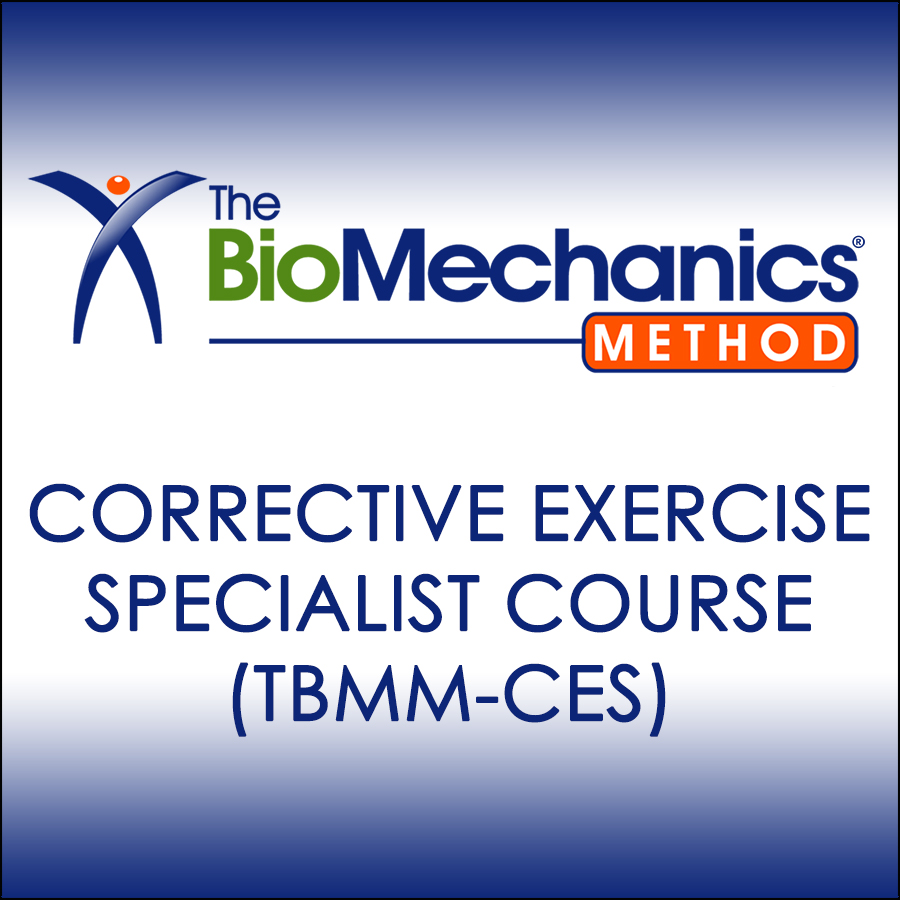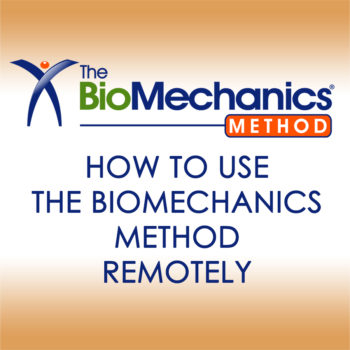The BioMechanics Method Corrective Exercise Specialist (TBMM-CES) course
The BioMechanics Method Corrective Exercise Specialist (TBMM-CES) certification course is the premier CES specialty education choice for exercise, health and fitness professionals. It includes all of the learning resources required to obtain the TBMM-CES credential. There are also additional benefits available only to TBMM Certificate holders.
The TBMM-CES course includes the following materials
- The BioMechanics Method Corrective Exercise Specialist (TBMM-CES) online course
What is in The BioMechanics Method Corrective Exercise Specialist (TBMM-CES) course curriculum?
To earn your TBMM-CES credential you will complete a comprehensive online course that consists of the following five modules:
- The Fundamentals of Structural Assessment
- Understanding Muscles and Movement
- The Fundamentals of Corrective Exercise
- The Complete Corrective Exercise Library
- Corrective Exercise Program Design
The Fundamentals of Structural Assessment (Module 1)
This learning module teaches a step-by-step process for conducting musculoskeletal assessments so you can identify common imbalances that can cause muscle dysfunction, joint discomfort and movement limitations. You will learn verbal, visual, and hands-on techniques for assessing the feet and ankles, knees, lumbo-pelvic hip girdle, thoracic spine and shoulder girdle, and the neck and head. You will also learn how musculoskeletal imbalances in one area of the body can cause problems in other areas.
Understanding Muscles and Movement (Module 2)
This learning module explains in easy-to-understand terms how the whole body moves together as an integrated series of muscles, tendons, bones, ligaments, and fascia; information that is essential for understanding the root causes of musculoskeletal imbalances. It will teach you about major muscle groups in detail, as well as specific muscle origins, insertions, and functions. Most importantly, you will discover the unique approach of The BioMechanics Method in regard to understanding how gravity and ground reaction forces change the way the body moves — knowledge that is imperative for designing effective corrective exercise programs.
The Fundamentals of Corrective Exercise (Module 3)
This learning module builds upon the knowledge and skills learned in Modules 1 and 2, and explains the most effective types of exercises for eliminating lower back, hip, shoulder, knee, neck, foot, and ankle dysfunction caused by common musculoskeletal imbalances. You will learn about self-myofascial release techniques that will enable you to alleviate restrictions in muscles and fascia, stretching exercises to help increase a client’s mobility and range of movement, and strengthening exercises to help people begin to move correctly and without limitations. You will also learn valuable strategies for regressing exercises when necessary, and then progressing exercises as a client’s abilities improve. Specific contraindications for each exercise type are also included to ensure safety and effectiveness.
The Complete Corrective Exercise Library (Module 4)
This learning module contains descriptions and demonstrations of almost 200 of the most effective corrective exercises for addressing musculoskeletal imbalances (including progressions and regressions). The fundamental principles of each corrective exercise category are highlighted and key teaching tips for every exercise are provided. This comprehensive collection of techniques serves as an exercise guide to help you to create programs that are most appropriate for a client’s needs.
Corrective Exercise Program Design (Module 5)
This learning module guides you through the corrective exercise program design process from start to finish, teaching you how to develop and use effective communication strategies when working with clients that have corrective exercise needs. Comprehensive, real-life case studies using actual clients are also included that demonstrate the complete The BioMechanics Method process. In addition to tying together the information from Modules 1-4, this fifth and final module of TBMM-CES course focuses on client communication skills, networking, and referral strategies so you can apply your skills within your scope of practice in the real world.
Is the (TBMM-CES) course approved for continuing education credit?
The BioMechanics Method Corrective Exercise Specialist (TBMM-CES) course is CEC-approved by the following:
- American Council on Exercise (ACE) – 8.0 CECs
- National Exercise Trainers Association (NETA) – 80.0 CECs
- American College of Sports Medicine (ACSM) – 80.0 CECs
- National Strength and Conditioning Association (NSCA) – 2.0 CEUs (Cat. C)
- CIMSPA – 10 CPDs
- Canadian Society for Exercise Physiology (CSEP) – 15 CPDs
- International Sports Sciences Association (ISSA) – 20 CEUs
- National Pilates Certification Program (NPCP) – 80 CECs
- REPS India – 7 CPDs
- REPs UAE – 16 CPDs
- REPs New Zealand – 20 CPDs
- Board of Certification (BOC) – 32.0 Category A CEUs
- Virginia Board of Physical Therapy (VBOPT) – 32.0 Type 1
- Athletics and Fitness Association of America (AFAA) – 15 CEUs
- National Academy of Sports Medicine (NASM) – 1.9 CEUs
The course is also eligible for continuing education credits from NESTA, NFPT, WITS, YMCA, and many other certifying organizations upon petition. Most physical therapy boards will reciprocate approval for continuing education. Please check with your state. The National Strength and Conditioning Association approved 2.0 CEU(s) in category C for certified individuals who successfully complete this course.
What will I be able to do upon completion of this course? (learning objectives)
- Implement a step-by-step process for conducting musculoskeletal assessments that can be utilized with any client to identify underlying imbalances that may cause or contribute to muscle dysfunction and/or movement restrictions.
- Evaluate the root cause of a client’s dysfunction by determining which muscles and soft tissue structures have been affected by musculoskeletal imbalances and movement limitations.
- Explain how gravity and ground reaction forces affect muscle function.
- Compare the differences between three major types of corrective exercises: self-myofascial release, stretching, and strengthening and identify how and when to utilize, progress, and regress each exercise type when working with clients.
- Identify and choose the most appropriate corrective exercises for a client’s condition from a library of exercises.
- Design effective corrective sessions and programs for clients to correct musculoskeletal imbalances.
What else do I need to know about The BioMechanics Method Corrective Exercise Specialist (TBMM-CES) course?
- Upon successful completion of this course you will receive your TBMM-CES certificate.
- This step-by-step course contains online lessons, digital text material, video instruction and demonstrations, assessment forms, self-check activities, and online tests. A computer and internet connection are required to access the course. A list of printable downloads is available for each course lesson under the course downloads tab. Digital material not itemized in the downloads tab of a course is not printable.
- Purchase price includes all online materials, unlimited free test retakes if necessary, and access to the course itself.
- Online courseware is non-refundable.
- Course prices are in US Dollars.
Benefits of completing The BioMechanics Method Corrective Exercise Specialist (TBMM-CES) course
- The BioMechanics Method Corrective Exercise Specialist (TBMM-CES) course is the highest-rated corrective exercise specialist credential in the fitness industry with Specialists in more than 75 countries
- A certificate recognizing your TBMM-CES Status
- Inclusion on The BioMechanics Method Online Specialist Referral Register
- Verification of TBMM Specialist Status on IDEA Fitness Connect
- Automatically eligible for TBMM Advanced Corrective Exercise Specialist course (Ad-CES)
- Earn valuable continuing education credit with major health and fitness certifying organizations
- Eligible to apply for Corrective Exercise Specialist of the Year® Award


Craig Bayer –
This course was amazing
Learning how the body works
And being able to help people that have issues.
Thank you for all the information
Amber –
It was a fun program to study
Jenny Lee –
Thanks! It was a good and interesting course, learnt a lot.
Kelly G –
I loved this course so much!!! I’m excited all of that I learned in this program and to start applying my new skills with clients.
Rob Campbell –
After completing The BioMechanics Method course I can now appreciate how truly integrated the human musculoskeletal system is and how even a slight deviation in one part of our body can cause significant pain and dysfunction in another seemingly unrelated part of our body. The course has enabled me to see just how massively important structural assessment, exercise selection, good form and proper alignment is in the design of any exercise program, particularly when helping those who are experiencing pain and are unable to enjoy the activities that they love in life. I highly recommend this course to any exercise professional who is interested in helping clients move with greater ease and freedom and with fewer life-affecting aches and pains.
Maria M –
This was an excellent course that gave me new information that has been really helpful to my clients. I also appreciate the attention to detail that was given to some of the psychological aspects that come with helping people to change habits for the better.
Melony –
I really enjoyed working with the program, getting this certification and look forward to implementing it. I believe there is a fit for it in the corporate world with which I am involved.
Christa K –
I most liked the video instructions and tutorials. In general I’m a more visual person than reading.
Ray H –
I’ve already started putting the method into practice with some current clients and they’re already loving it:)
Amanda D –
This was such a great course!